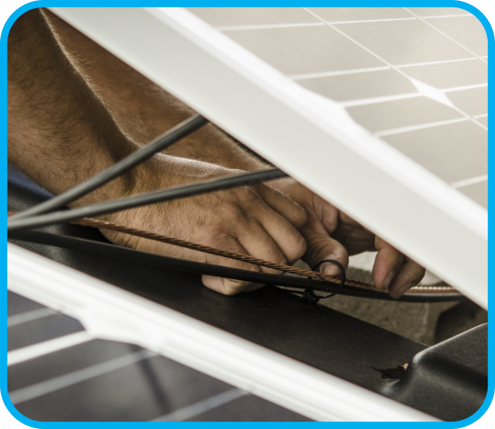
How Wire Management Materials Impact the Lifespan of Solar PV Installations
This white paper discusses one of the questions we hear most often regarding wire management for solar applications: Which is better – metal or plastic?
While there is no easy answer, this paper will help solar designers and installers understand the qualities of metal, plastic and plastic-coated metal wire management components. We include a primer on different plastic compounds best suited for long life in the menacing solar environment.
HellermannTyton presents this information based on years of qualitative evidence we have
gathered from utility-scale installations located in some of the most environmentally challenging environments in North America.
Metal
Perhaps the number one reason some installers prefer metal is it offers long service life. However, cable insulation can wear away or be sliced open due to sharp edges often found on metal fasteners, resulting in the potential for arc faults. This damage to the cable is often exacerbated by wind, thermocycling of cables, tracker motion or simply an installer pulling the cable too tightly or at an inappropriate angle.
With metal products, minor differences in design can have major implications.
Competitors’ Metal Edge Clips
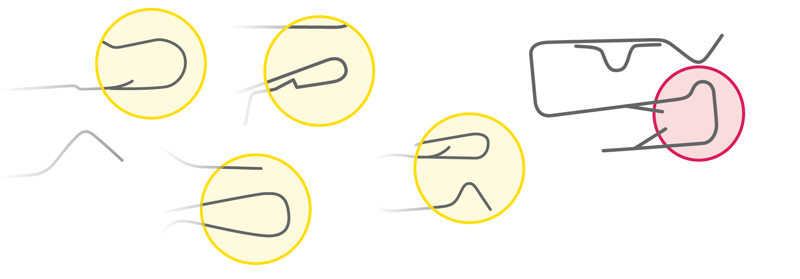
These illustrations show how some solar edge clips have small push points that cause installers to experience thumb pain with repeated use. Installing hundreds of thousands of HellermannTyton edge clips on an average solar farm increases efficiency and installation quality, saving potentially hundreds of hours in labor and strain-related downtime versus poorly engineered clips. And thanks to remarkable engineering, our clip offers the lowest insertion force and highest extraction resistance in the industry.
Another engineering focus for our line of metal edge clips is designed in cable protection. Not only do we incorporate a leaf spring into the design, allowing for less direct metal-to-wire contact, we also round the edges in critical areas. Many suppliers simply deburr edges during the manufacturing process. We take risk mitigation further by using rolled steel. While other metal clips show sharp, hard edges, our advantage shows off in the details. Rolled steel edge clips are far less likely to nick or damage PV cables over the life of the system, through all the wind gusts and thermocycling, perching birds and busy installers rushing their work after a long, hot day on the roof.
In summary, metal offers long service life, but there are dangers in wrapping a high voltage cable in it. By choosing metal, you are choosing a material that is conductive and could eventually cause a short or arc fault. That’s why our metal fasteners have coined edges, which reduce the chances of this happening. The risk is potentially increased depending on installation procedures by field installers. That’s why we focus on the smallest details of metal wire management components as well as best installation practices.
Plastic
Selecting the Right Engineered Plastic
Off-the-shelf materials are appropriate for general-purpose applications, but in solar, they provide short-term value that can quickly lead to uncontrolled maintenance costs. Simple UV-rated and PA66 outdoor grade materials can deliver in certain situations but fail to measure up to environmental extremes. When opting for an engineered plastic, you are choosing a softer material than metal, which makes it less likely to slice through a cable jacket, but climate and site conditions will need to be carefully considered to determine what products make the most sense for a given application.
Our solar materials are formulated with UV stabilizers, UV absorbers or exceptionally strong base plastics designed for extended lifespans. Depending on your application, we offer budget-friendly solutions that outlast so-called value-priced products – all the way up to our new 25-year PVDF products for the most maintenance-free cable management you can get.
How Our Materials Compare
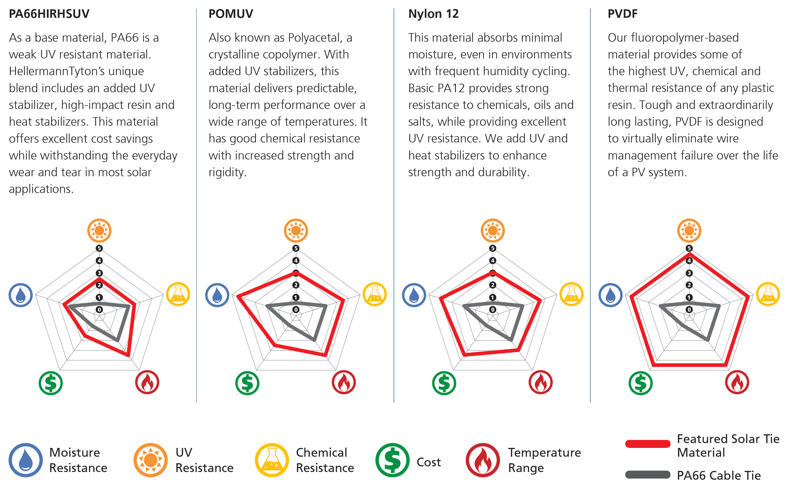
Temperatures and Heat
Rooftop solar installations can often reach 160-180 degrees F (70 to 82 degrees C) and utility-scale solar farms are often installed in some of the hottest regions of the world. When talking about solar systems and wire management, temperature is one of the most common reasons plastic components fail.
Most cable ties from the big box stores are rated for a maximum of 150 degrees F. While the price may be “right,” these ties become brittle and begin to break down in a matter of months, not the years a PV system is rated for. All HellermannTyton engineered Solar Ties are rated for their environments, especially temperature. For over 50 years, we have been the market leader in providing engineered products for almost every automotive, farm equipment and heavy-duty truck manufacturer in the world. With that comes a deep understanding of temperature effects and what it takes to make a product last. That knowledge combined with our solar expertise is why many of the top solar companies have installed our parts on over 10 GWs of solar worldwide.
The graphs below reveal how temperature can impact fastener strength. The data on the left shows strength over time at 30 degrees C; the graph on the right that shows how much faster plastic materials degrade at high temperatures. Heat stabilizers and heat stabilized materials are critical when specifying long-lasting wire management products.
Fluorescent UV lamp, 45W/m2 (300-400 nm)
 Acc. to TABOR and WAGENMAKERS Source: Atlas Material Testing Solutions
Acc. to TABOR and WAGENMAKERS Source: Atlas Material Testing Solutions
Moisture Resistance
We normally don’t think of plastics absorbing water, but they do. Nylons (PA66/polyamides) are hygroscopic materials, meaning they absorb and release moisture. Water content in polyamides is important during the manufacturing process. It’s also important for the molded part’s physical properties, as the mechanical properties of a polyamide material are affected by its water content – especially flexibility and minimum tensile strength. A base PA66 is the least stable of materials. HellermannTyton’s proprietary blend, PA66HIRHSUV, stands up better to moisture fluctuations, especially in very dry conditions, because of its impact modifier. The impact modifier keeps the material from becoming brittle, even in the driest of conditions. Nylon 12, POM and PVDF have non-hygroscopic base materials, meaning they are much less affected, if at all, by moisture.
Chemical Resistance
Many chemicals can come into contact with a PV array, including those sprayed for dust and vegetation suppression, pest control and other various elements. One of the main benefits of plastic wire management is eliminating the chance of dissimilar metals reacting with one another. This is a concern we have heard from many developers over time. By choosing a plastic wire management solution, corrosion is less of a concern. Galvanic corrosion from salts and moisture can also play a part in the strength of metal wire management components.
UV Exposure
UV exposure can be an issue even on the back of a panel. Between 20 and 30 percent of the sun’s energy can hit the back of the panel due to the reflectance – measured in albedos - of the soil. Our solar materials are formulated with UV stabilizers, UV absorbers or exceptionally strong base plastics designed for extended lifespans.
Lifespan of UV Materials
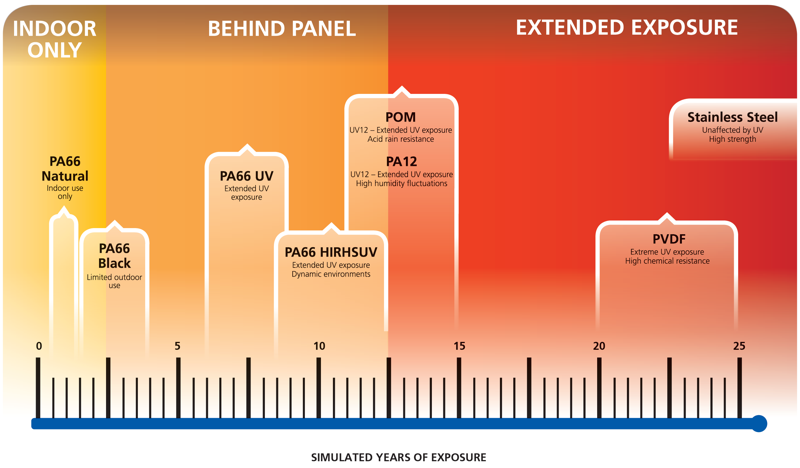
Several factors come into play when selecting the right material for your application. Choose an engineered plastic made for harsh outdoor environments. In addition to protecting the conductors from failure in long-term UV exposure locations, it also helps lower your maintenance costs over the life of the system.
Plastic-Coated Metals
On paper, a metal wire management component coated in plastic or rubber appears to be the best of both worlds – the durability of metal with the insulating properties of plastic. Our experience in the field has identified flaws in both the design and application of these parts.
Coatings adhere poorly to stainless steel. We have seen many field failures – coatings breaking off after only a few years of environmental exposure. This seems to be most common with coated stainless-steel cable ties. Many vinyl-coated parts, such as P-straps, cushion clamps, one-holes, etc. are protected by a coating that is in no way suitable for tough, outdoor applications.
Other issues occur from installation errors including exposing the protective coating to a sharp metal edge. The most common sharp metal edge is the module mounting hole.
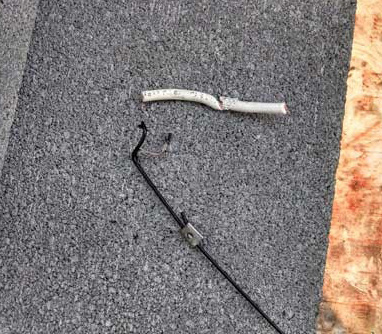
A vinyl coated, stainless steel tie cinched so tight that it cut through the wire. Photo source: PV Pros, Inc.
These issues with the protective coating all result in exposure of conductors to the underlying metal. Often, the wire management part is installed in a manner that necessitates the protective coating remain intact. For example, using a clamp at the end of the row on a single-axis tracker system ensures the bundle survives the constant motion of the tracker and other forces (UV, wind, thermocycling of cable, etc.). However, if the coating peels off or the cushion slips out of the clamp, the result is a moving bundle of cable against a narrow, metal edge.
One further issue with these parts, relating to longer term O&M costs, is detection. If a plastic wire management component fails, the need for correction is obvious. If the coating on a metal part fails, it may be impossible to see damage to conductors. This can lead to arc issues that may cost much more than the replacement costs of failed wire management.
Summary
All wire management systems are subject to improper installation. It is imperative to understand the installation crew’s capabilities and the care they will give to the smallest details of securing wire safely. Or, chose a fastener that is tolerant of a wide variety of installation methods.
In choosing a particular material or type of wire management component, metal tends to be more forgiving to install but less forgiving to the cable if installed improperly. Plastic wire management runs the opposite, requiring more care to install but ultimately gentler on cable insulation.
These considerations are an important part of your wire management strategy to ensure a long-term solar installation.
HellermannTyton has gigawatts of global experience in selecting the suitable wire management components and strategy for your solar sites environmental hazards.
See the 25-year rated PVDF Cable Tie from HellermannTyton. Specification. Article.